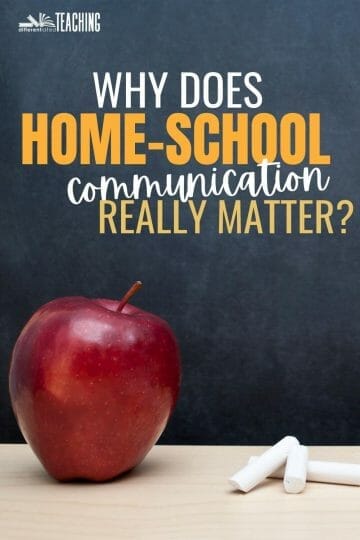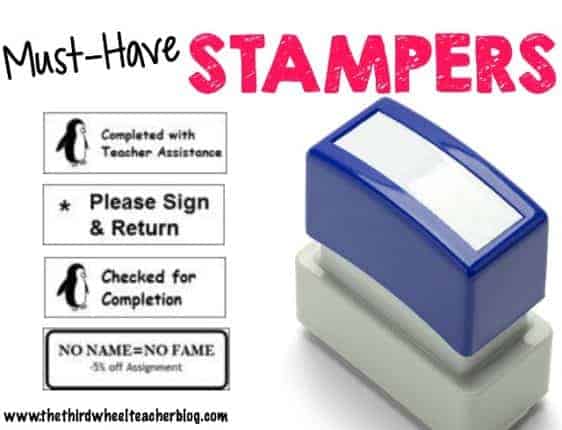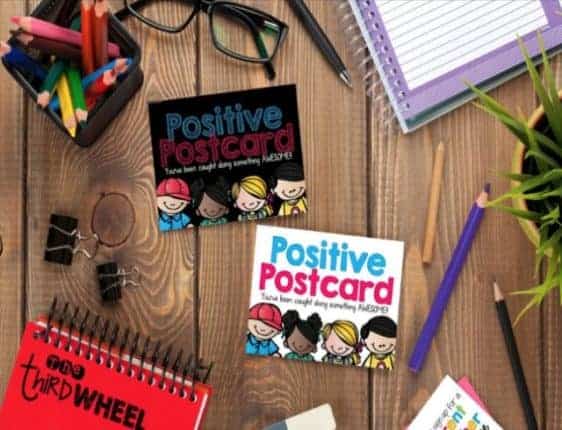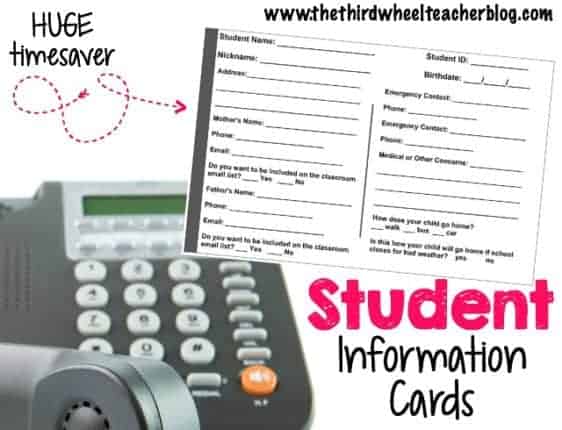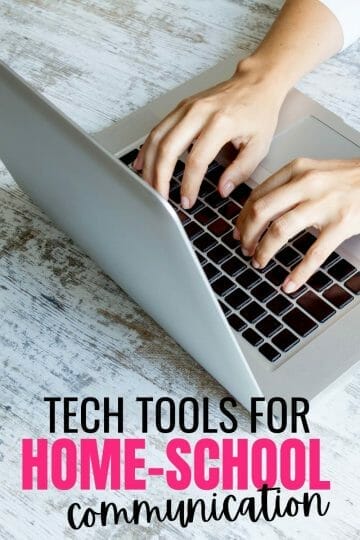Organize for Better Home-School Communication
Building a strong relationship between home and school is a critical piece of teaching, but it can be tough to do if you don’t feel confident in how best to do so. Most teacher education programs do little to prepare new educators for collaborating with their families in the classroom so we are typically left to figure it out as we go. However, home-school communication is a critical part of an effective classroom.
Today I want to share the basics of effective parent-teacher relationships. I’ll also share some quick tips for easily starting the positive relationship you want to have with families.
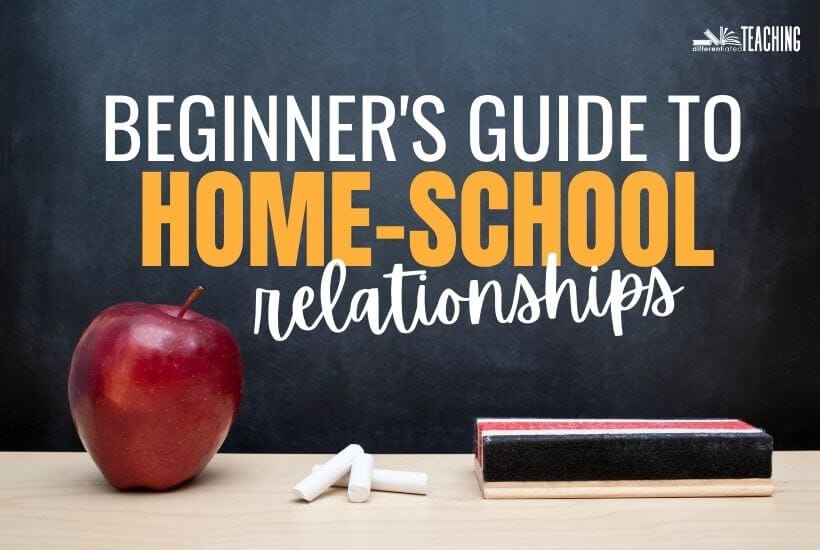
What is school to home communication?
In the most basic sense, Home-School Communication is a collaborative relationship between the home and school that is based on mutual trust and respect.
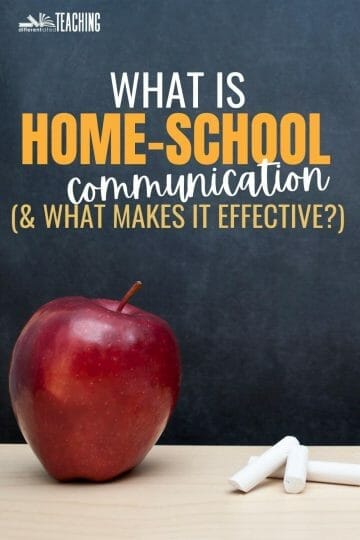
When it’s working well it helps students feel connected to their school as well as the adults who are teaching them. It also helps teachers find out what is going on at home and what needs to happen to support their student’s growth at home, in the classroom, and in the community
The formula for building a genuine partnership and environment of trust is simple: Communicate, listen, respond with empathy and use helpful resources at home and school to support learning.
Why is home-school communication important?
Parent-teacher communication is important for a number of reasons. Having a strong relationship with the school helps children feel confident and supported in their learning. It helps build parent confidence and trust.
In fact, a strong relationship between home and school has been shown to lead to higher academic achievement and better student outcomes. and builds positive relationships within the school community.
One of the most important things a teacher can do to foster a strong relationship with families is to communicate with parents. Give them a basic overview of what their child will learn during events like Curriculum Night.
Reach out in advance of an IEP meeting to discuss any concerns if the child is receiving special education services.
The foundation of good communication in the home-school collaboration is listening. Engaging in a two-way conversation helps build a strong relationship between home and school.
My Top Tools for Building Home-School Connections
Effective communication is a critical piece of teaching, but it is also a stressful piece. Organizing for home-school communication is something that I take really seriously, and I like to set myself up for success by having some basic supplies each year.

Here are a few of my favorite tools, I have collected over the years…some are inspired by others, and several are my own designs. I use them for quick communication in my classroom:
1. Home-School Communication Stampers for Ongoing Feedback
One of the easiest parent communication strategies I use is my stamper set. These allow me to easily engage in the basics of school-home communication and keep parents up-to-date on the details of assignments and the supports I’m providing to students.
This is HUGELY beneficial when it comes time for report cards and parent-teacher conferences because it reduces the number of surprises that happen.
These are a huge help for student planners, assignments, and more. They save me huge amounts of time and let me better track and communicate the support I am providing to students.
I use the stamps on student assignments, to quickly mark planners, and to save me time. Below are my four most used stamps.
Home-school communication is something that I always strive to master. There is still work to be done, but these stampers definitely help.
2. Postcards to Share Positive Feedback
Positive postcards are one of my favorite lines of communication. As a form of communication, it offers a chance to focus on more than just academics. I often send these postcards for improvement or when I notice a student displaying one of the core values in our classroom.
I typically don’t tell students that I’m mailing the postcards, as I love the surprise of having them arrive at home and hearing about how excited the student was to receive real mail.
I’ve found that this practice has really enhanced relationships with families and has been a huge boost to many learners who normally don’t get many calls or notes home.
I’ve found that even middle school students love to receive these post cards, although they tend to be a little less boisterous about it in class. There’s something about a little encouraging feedback that really helps foster that relationship.
I have created postcards for welcoming students back, scheduling and reminding about picture day and parent conferences, and more.
However, my favorite is definitely the positive postcard shown above. I try to send 2 per student each year with a little note about something I noticed they did that was above and beyond the norm for them.
If you love the design, you can get my whole set here for under $5: Parent Communication Postcards
3. Student Information Cards to Maintain Personal Contact with Parents
n order to build a strong partnership between schools and home, we need to be able to reach out and connect with parents. One of the most important pieces of information we need is HOW to connect. In order to get the ball rolling and initiate respectful two-way communication, I like to have parents fill out these student information cards.
They give parents a chance to give me information on how they prefer to be contacted, which is really important because a positive relationship can be a challenge if you’re constantly calling a parent at work or emailing an address that is no longer being used.
I also ask parents what communication channel works best for them – digital communication, a phone call, or a note home.
Plus, I’ve found these cards are a lifesaver. I use them ALL. THE. TIME!
At the beginning of the year, I have parents fill them out (they are each a half-sheet of cardstock), and I hole punch them. I place them on a large ring in ABC order.
I hang them by my phone, door, or emergency readiness kit to make things easy . As a result, I no longer have to dig for parent information when I need to make a quick call home during planning, and I’m not leafing through binder trying to find what I need on an ongoing basis.
Click the button to get a free copy of my student information cards sent right to your inbox.

4. Address labels for Quick One-Way Communication
You might be wondering how I use address labels as a tool for building parent-teacher relationships. I know they don’t seem like it, but they are really helpful for quick, consistent communication.
Here are a few examples of labels I’ve used in the past:
- Request volunteers & solicit parental involvement for an upcoming event
- Inform parents when their child is out of a specific school supply (like glue)
- Share progress notes on common goals
- Offer reminders about school events
Much like the stampers I mentioned above, these are another great tool for adding to papers and planners. Some of the more basic labels just offer positive feedback on student progress. However, others are are more detailed forms of communication.
For example, the Redo & Return label shown below is my favorite. I use it on assignments where the student scored below a 70% and can redo the task for more points.
My “Supplies Needed” label is bright yellow and has space to write what supply students need to bring. Consequently, parents are able to quickly and easily replenish anything that runs out.
Side note: Address lables aren’t just for home-school communication! I even have a label I use for documents that need to be passed to my whole team. The label has the initials of each member of our team.
Everyone crosses off their initials to show they have seen it when the document comes to them. As a result, I’ve saved a ton of time writing our initials every time we have to share a paper.
Communication Technologies for Building Relationships with Parents
In addition to the ideas above, there are now a number of websites for communicating with families. These home-school communicate sites are great for middle school and elementary teachers.
Here are a few of my favorite for sharing digital messages:
No matter how you decide to engage families, in my experience, the best way to build home-school relationships is to get parents involved in what’s going on at school. This doesn’t mean they should have daily updates about lesson plans or grades. It means keeping them in the loop and giving them opportunities to be actively involved whenever possible.
It also means recognizing that they want what is best for their child. Most parents are doing their best to offer their children a good experience at school and a happy childhood. Therefore, honest, open communication is key. Recognize strengths and show you are a partner to support a strong parent-teacher relationship.
What tools do you use to help organize and streamline your home-school collaboration?

